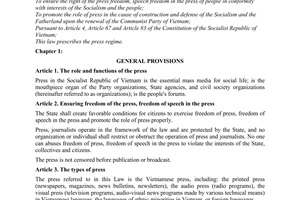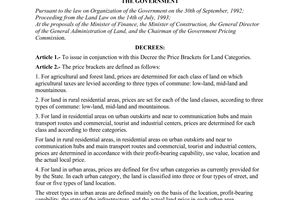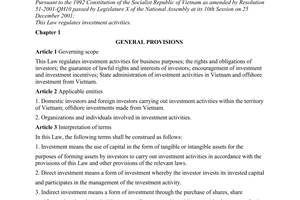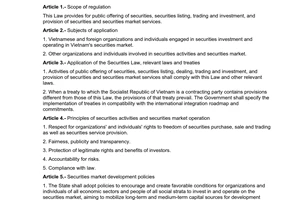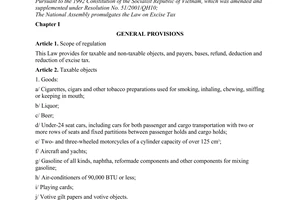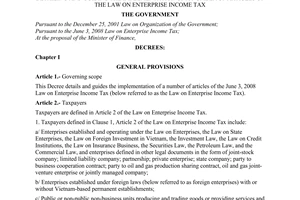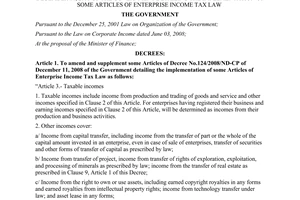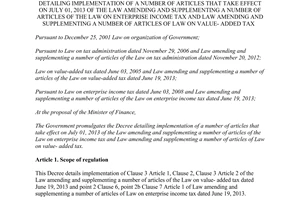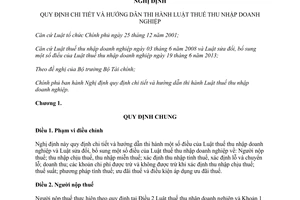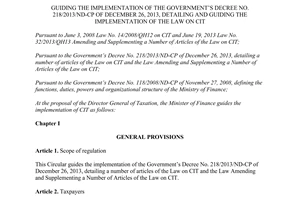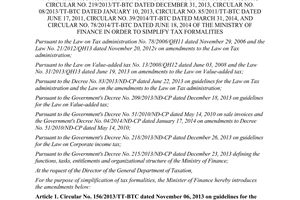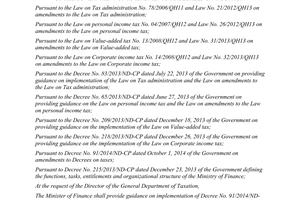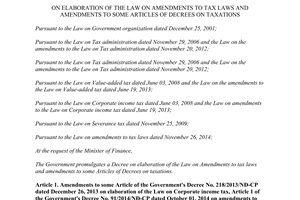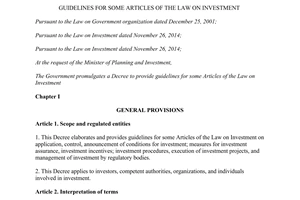Nội dung toàn văn Decree No. 218/2013/NĐ-CP guiding Law on corporate income tax
|
THE
GOVERNMENT |
SOCIALIST
REPUBLIC OF VIETNAM |
|
No.: 218/2013/ND-CP |
Hanoi, December 26, 2013 |
DECREE
DETAILING AND GUIDING THE IMPLEMENTATION OF LAW ON CORPORATE INCOME TAX
Pursuant to the Law on organization of Government dated December 25, 2001;
Pursuant to the Law on corporate income tax dated June 3, 2008 and the Law amending and supplementing a number of articles of the Law on corporate income tax dated June 19, 2013;
At the proposal of the Minister of Finance;
The Government issues the Decree detailing and guiding the implementation of the Law on corporate income tax;
Chapter 1.
GENERAL REGULATION
Article 1. Scope of adjustment
This Decree regulates in detail and guides the implementation of a number of articles of the Law on corporate income tax and the Law on amending and supplementing a number of articles of the Law on corporate income tax including: taxpayer, taxable i
ncome, Exempt income, determination of taxable income, loss and loss carrying; revenues, deducted or undeducted expenses when determing the taxable income, tax rate, method of tax calculation, tax incentives and conditions for application of tax incentives;
Article 2. Taxpayer
The taxpayers shall comply with the provisions in Article 2 of the Law on corporate income tax and Clause 1, Article 1 of the Law amending and supplementing a number of articles of the Law on corporate income tax;
1. The taxpayers as prescribed in Clause 1, Article 2 of the Law on corporate income tax include:
a) Enterprises established and operating under regulations of Enterprise Law, Investment Law, the Law on Credit Institutions, Insurance Business Law, Securities Law, Petroleum Law, Commercial Law and the provisions of other legal documents in the forms: Joint stock companies, limited liability companies, partnerships, private enterprises, the parties in a business cooperation contract, the parties in petroleum product sharing contract, petroleum joint venture enterprises and joint operating companies;
b) Enterprise established under the regulations of foreign law (hereinafter referred to as foreign enterprises) with or without a permanent establishment in Vietnam;
c) Public and business enterprises or non-public and non-business enterprises producing and trading goods have their taxable income as prescribed in Article 3 of this Decree;
d) Organizations established and operating under the Law on Cooperatives;
dd) Other organizations other than the ones specified at Points a, b, c, d of this Clause with the business and production activities have their taxable income as prescribed in Article 3 of this Decree;
2. Organizations established and operating (or registering operation) under regulations of Vietnamese law, the business individuals as taxpayers by the method of deduction at source in case of purchase of services (including purchase of services associated with goods or purchase of goods provided or distributed in the form of on-the-spot import export or under international commercial terms) based on contract signed with foreign enterprises specified at Point c and d, Clause 2, Article 2 of the Law on corporate income tax
The Ministry of Finance specifically guides the tax deduction in this Clause;
Article 3. Taxable income
1. The taxable income includes income from the business and production activities of goods and services and oher income specified in Clause 2 of this Article. For enterprises registering business and having income specified in Clause 2 of this Article, this income is determined as the one coming from the business and production activities of the establishment;
2. Other income includes:
a) Income from capital transfers includes income from the transfer of a part or whole of the capital invested in the enterprise, including the sale of enterprise, transfer of stock or transfer of capital contribution rights and other forms of transfer of capital as prescribed by law;
b) Income from transfer of investment projects, income from the transfer of the right to participate in investment projects, income from the transfer of rights to explore, extract and process minerals prescribed by law; income from transfer the real estate as stipulated in Article 13 and 14 of this Decree;
c) Income from the right to use and own property including income from the intellectual property rights, income from technology transfer under the provisions of law;
d) Income from transfer, lease or disposal of property (excluding real estate), which contains other valuable papers;
dd) Income from interest from deposit and interest from loan and trading of foreign currency includes: Interest from deposit at credit institutions, interest from loans in any form as prescribed by law, including deferred interest, interest paid instalments, fees of credit guarantee and other fees in the contract of loan; income from trading of foreign currency; exchange rate difference from revaluation of liabilities payable in foreign currency at the end of fiscal year; exchange rate difference arising in the period (for exchange rate difference arising during the basic construction investment to form the fixed assets of newly-established enterprises but these fixed assets have not been put into the business and production activities, the guidance of the Ministry of Finance shall apply). For debts receivable and loan in foreign currency arising in the period, the exchange interest difference of debts receivable or loan is the difference between the exchange rate at the time of debt collection with the exchange rate at the time of recording of debts receivable or initial loan;
e) Deductions advanced as expenses which are not used or have not been used up in the period of deduction are not accounted by enterprises to adjust for reducing expenses;
g) Debts written off now recovered;
h) Liabilities payable without identifying creditors;
i) Income from the business of the previous years omitted now discovered;
k) The difference between the collection of penalty or compensation for breach of economic contract or bonus from good performance of commitments (excluding the fines or compensation is reduced in the value of works during the investment period) minus (-) the penalty or compensation due to breach of contract as prescribed by law.;
l) The grants in cash or in kind received;
m) Differences from revaluation of assets as prescribed by law to contribute capital or transfer upon splitting, merger, consolidation or conversion of business type.
Enterprises receive the assets accounted by re-evaluated price when determing the deductible expenses specified in Article 9 of this Decree;
n) Income received from business and production activities outside Vietnam;
o) The other incomes including Exempt income specified in Clause 6, Clause 7, Article 4 of this Decree.
3. The taxable income arising in Vietnam of foreign enterprises specified at Point c and d, Clause 2, Article 2 of the Law on corporate income tax is the income received originates from Vietnam from activities of services supply, goods distribution and supply, loans, royalties for organizations and individuals or foreign organizations and individuals doing business in Vietnam, not dependent on business location;
The taxable income specified in this Clause does not include the income from services performed outside the Vietnamese territory such as: repair of means of transportation, machinery and equipment abroad; advertising, marketing, investment promotion and commercial promotion abroad; brokerage for goods or services sales abroad; training abroad, sharing the postal service and international telecommunications charges to the foreign party;
The Ministry of Finance specifically guides the taxable income specified in this Clause;
Article 4. Exempt income
The Exempt income shall comply with the provisions in Article 4 of the Law on corporate income tax and Clause 3, Article 1 of the Law amending and supplementing a number of articles of the Law on corporate income tax;
1. Income from farming, raising, aquaculture, salt production of cooperatives; income of cooperatives operating in the field of agriculture, forestry, fishery and salt industry done in areas with difficult or extremely difficult socio-economic conditions; the income of enterprise from the farming, raising, aquaculture in areas with extremely difficult socio-economic conditions; income from fishing activities.
Income from farming, raising and aquaculture of cooperatives and enterprises exempted from tax as prescribed in this Clause does not include the income from processing and making of products from farming, raising, aquaculture. The cooperatives and enterprises shall separately account the income from the farming, raising and aquaculture with the other areas of processing and making to determine the amount of income tax from which the enterprises are exempted in this Clause. In case of failure to separately account, the tax free income shall be determined by the ratio of expenses of tax exemption activities with the total cost of production and business of the establishment in the tax period.
The farming, raising and aquaculture activities of cooperatives and enterprises in the area with extremely difficult socio-economic conditions exempted from tax as prescribed in this Clause and at Point e, Clause 2, Article 15 of this Decree are determined by the economic sector code of level 1 of agriculture, forestry and fisheries sector specified in the System of Sectors of Vietnam Economy;
Cooperatives operating in the field of agriculture, forestry, fisheries and salt industry specified in this Clause and in Clause 2 of Article 15 of this Decree are the ones meeting the rate of supply of products and services to the members who are individuals, family households and legal entities engaged in agriculture, forestry, fishery and salt industry under the provisions of the Law on Cooperatives and guiding documents.
2. Income from the performance of technical services directly serving agricultural exempted from tax includes: income from water irrigation and drainage services, plowing, harrowing, dredging of canals and ditches in the field; insect and diseases prevention services for crops, livestock; services of agricultural products harvest.
3. For income from the performance of the contract for scientific research and technological development, income from the sale of products made on trial and income from products made by new technology first applied in Vietnam. The tax exemption period must not exceed 01 year from the start date of revenue from the sale of products under the contract for scientific research and technological application, production on trial or by new technology;
The Ministry of Finance specifically guides the provisions in this Clause
4. Income from business and production activities of goods and services of enterprises having more than 30% of average number of employees as disabled, rehabilitated persons and HIV/AIDS sufferers;
Enterprises exempted from tax specified in this Clause are the ones having the annual average number of employee from 20 persons or more, not including enterprises operating in the field of finance and business of real estate;
Exempt income specified in this Clause does not include other income specified in Clause 2, Article 19 of this Decree;
5. Income from vocational training dedicated to the ethnic minorities, the disabled, underprivileged children, the objects of social evils, the persons under rehabilitation, the rehabilitated persons, drug users, HIV/AIDS sufferers. Where the vocational training school includes other subjects, the Exempt income is determined by the ratio between a number of ethnic minorities, the disabled, underprivileged children, the objects of social evils, the persons under rehabilitation, the rehabilitated persons, drug users, HIV/AIDS sufferers and the total learners of the establishment.
6. Income divided from capital contribution, share purchase, joint venture and economic association with domestic enterprises. After the party receiving the contributed capital, issuing stocks or performing the joint venture and association has paid tax under the provisions of the Law on corporate income tax, including the case where the party receiving the contributed capital, issuing stocks or performing the joint venture and association is enjoying preferential tax specified in Chapter IV of this Decree.
7. The grants received are used for educational activities, scientific research, culture, art, charity, humanity and other social activities in Vietnam.
Where the organization receiving grants and using them for improper purpose must pay the corporate income tax calculated on the improper use in the tax period with the improper use.
Organizations receiving the grants specified in this Clause is the ones which are established and operating under the regulations of law and comply with regulations of law on statistics accounting;
8. Income from transfer of Certified Emission Reduction (CER) credit of enterprises first issued with Certified Emission Reduction (CER) credit, for the following transfers, the corporate income tax shall be paid as prescribed.
9. Income from performing the tasks assigned by the Vietnam Development Bank on development investment credit, export credit; income from credit activities for the poor and other subjects enjoyed preferential treatment policy of Vietnam Bank for Social Policies; income of one member limited liability companies managing the assets of Vietnamese credit Institutions; income from revenue-generated activities by performing the tasks assigned by the State of the State financial funds:Vietnam social insurance Fund, the deposit insurers, the health insurance Fund, the vocational training support Fund, the overseas employment support Fund of the Ministry of Labor, Invalids and Social Affairs, the famer support Fund, Vietnam legal aid Fund, the public-utility telecommunications Fund, the local development investment Fund, Vietnam environmental protection Fund, the credit guarantee Fund for small- and medium-sized enterprises, the cooperative development aid Fund, the poor women support Fund, the protection Fund for citizens and legal persons in overseas, the housing development Fund, the development Fund for small- and medium-sized enterprise, the national scientific and technological development Fund, the National technological innovation fund; Incomes from the performance of tasks which are assigned by the State of the housing and land development Fund and other funds of the State that are decided for the establishment by the Government and Prime Minister and operating under Vietnam's laws
10. The undivided income of the establishments socializing the education, training, health and other socialized fields (including Offices of judicial expertise) is left for investment and development of those establishment as prescribed by specialized law on education – training, health and other socialized fields; the income formed from the undivided assets of cooperatives which are established and operating under the provisions of the Law on cooperatives;
11. Income from technology transfer under priority fields transferred to organizations and individuals in the areas with the extremely difficult socio-economic conditions;
Chapter 2.
GROUNDS AND METHOD OF TAX CALCULATION
Article 5. Grounds for tax calculation
The grounds for tax calculation are the taxable income in the period and tax rate;
The tax period shall comply with the provisions in Article 5 of the Law on corporate income tax and regulations of law on tax management;
Enterprises may choose the tax period by solar calendar year or fiscal year but must inform the tax authority before implementation;
Article 6. Determination of taxable income
1. The taxable income in the tax period is determined as follows:
|
Taxable income |
= |
Assessable income |
- |
Exempt income |
+ |
Losses carried forward as prescribed |
2. The accessable income is determined as follows:
|
Assessable income |
= |
Revenue |
- |
Expenses deducted |
+ |
Other income |
Enterprises having many business activities, then the accessable income from business and production activities is the total income of all business activities. Where there is a loss of business activity, the loss shall be offset from the accessable income of income-generating business activities selected by enterprises. The remaining income after offset shall apply the tax rate of corporate income tax of business activities still generating income.
Income from the transfer of real estate, transfer of investment project, transfer of right to participate in investment projects, transfer of mineral exploration, mining and processing rights must be determined separately for tax declaration. Where the transfer of right to participate in investment projects, transfer of investment projects (except for projects of mineral exploration and mining) or transfer of real estate has losses, such losses are offset against profits of the production business activities in a tax period. Where the enterprises perform the dissolution procedures selling real estate as fixed assets, the income from the transfer of real estate (if any) shall be offset against income from production and business activities of enterprises.
3. The determination of assessable income for certain business and production activities is regulated as follows:
a) Income from capital transfer (excluding income from securities transfer specified at Point b of this Clause) shall be determined by the total amount collected under the transfer contract minus (-) the purchase price of the capital transferred, minus (-) expenses directly related to the transfer.
Where enterprises transferring capital do not receive cash but assets or other material benefits (such as stocks or fund certificates) with income generated, they must be subject to the corporate income tax;
b) Income from transfer of securities is determined by the sale price minus (-) the purchase price of securities transferred, minus (-) the expense directly related to the transfer of securities.
Where enterprises issue stocks, the difference between the issue price and the face value without corporate income tax;
Where enterprises conduct the separation, splitting, consolidation or merger with stock swap done at the time of separation, splitting, consolidation or merger, if the income is generated, this income must be subject to corporate income tax.
Where enterprises transferring securities do not receive cash but assets or other material benefits (such as stocks and fund certificates) with income generated, they must be subject to the corporate income tax;
c) Income from intellectual property rights or technology transfer is determined by the total amount collected minus (-) prime cost or expenses to create intellectual property rights or technology transfer, minus (-) the cost of maintenance, upgrading and development of intellectual property rights, technology transfer and other expenses deducted;
d) Income from lease of assets is determined by the leasing income minus (-) depreciation deductions, costs of maintenance and repair of assets, costs of lease of assets for sub-leasing (if any) and other costs deducted relating to the lease of assets;
dd) Income from transfer or disposal of assets (excluding real estate) by the proceeds from the transfer or disposal of assets minus (-) the residual value of the assets recorded on the accounting books at the time of transfer or disposal and the costs deducted relating to the transfer or disposal of assets;
e) Income from the trading of foreign currency by the total proceeds from the trading of foreign currency minus (-) the prime cost of amount of foreign currency sold;
g) Differences from the revaluation of assets or transfer upon separation, splitting, consolidation, merger, dissolution, conversion of business type, conversion of owners contributing capital is the difference between the re-evaluated value of assets with the remaining value of thoses assets recorded on the accounting books before the revaluation of assets.
Increasing or decreasing differences resulting from the revaluation of fixed assets upon capital contribution, or transferred assets upon separation, splitting, consolidation, merger or transformation of enterprises, assets being the land use right value upon capital contribution to investment projects on building houses or infrastructure for sale shall be accounted as other incomes in a tax period; particularly, the difference resulting from the revaluation of land use right value used for capital contribution in which the capital contribution receiving party is not allowed to depreciate, shall be gradually accounted as other incomes for a maximum of 10 years from the year of capital contribution by assets;
h) For business cooperation contract (BCC) with division of profits after tax, the income is determined by total revenue under BCC minus (-) the total costs related to the revenue generation of BCC .
The Ministry of Finance specifically guides the determination of revenue and costs of BBC with division of profits after tax;
i) The income received from business and production activities abroad is the total revenue received before tax;
4. Income from exploration and extraction of oil and gas is determined by each oil and gas contract;
Article 7. Determination of loss and loss transfer
1. Losses incurred in a tax period is the negative (-) difference of taxable income excluding losses carried forward from the previous years shall be determined by the formula specified in Clause 1, Article 6 of this Decree.
2. Enterprises with loss shall carry their losses forward to the subsequent year and are deducted from taxable income. The time permitted for loss transfer is continuously calculated but not exceeding 5 years from the year following the year with loss incurred.
3. Loss from transfer of real estate, investment projects or right to participate in investment projects (except for project of mineral exploration and mining) after being offset with the assessable income of these activities or loss offset under the provisions of Clause 2, Article 6 of this Decree. If losses remain and enterprises suffer from losses from the transfer of mineral exploration and mining rights, they may carry their losses forward to the subsequent year into the taxable income of those activities.The time permitted for loss transfer is continuously calculated but not exceeding 5 years from the year following the year with loss incurred.
Article 8. Revenue
The revenue to calculate assessable income shall comply with the provisions in Article 8 of the Law on corporate income tax;
1. The revenue to calculate the taxable income is the total sale, processing and services supply proceeds including price subsidies, surcharges or extra enjoyed by enterprises, irrespective of whether or not the proceeds have been collected or not.
For enterprises declaring and paying value added tax by the method of tax deduction, the revenue to calculate the corporate income tax is the revenue without value added tax. For enterprises declaring and paying value added tax by the direct method on the added value, the revenue to calculate the corporate income tax includes the value added tax;
2. The time to determine the revenue to calculate the taxable income for goods to be sold outis the time to transfer the ownership or the right to use of goods to the purchasers;
The time to determine the revenue to calculate the assessable income for services is the time to finish the services supply to the purchasers or the time to issue invoice of services supply;
3. The revenue to calculate the assessable income for several cases specified as follows:
a) For goods sold by installment payment determined by the selling price paid once, not including payment of interest by installments or deferred payment;
b) The goods or services used to exchange or internally consume (excluding the goods and services used to continue the process of business and production of enterprises) are determined by the selling price of products, goods or services of the same type or similar at the time of exchange or internal consumption;
c) For goods processing activities are the proceeds from the processing activities including wages, cost of fuel, power, auxiliary materials and other costs for the processing of goods;
d) For asset leasing activities, golf course business activities or other services business services that customers have prepaid for many years as the amount the asset lessee or services purchaser has paid by each period under contract. Where the asset lessee or services purchaser has prepaid for many years, the revenue to calculate the assessable income is allocated to the number of year prepaid or determined by the lump sum revenue. Where the enterprises are enjoying the tax incentives, the determination of incentive tax should be based on the total income tax the enterprise should pay of the number of year prepaid divided (:) by the number of year prepaid;
dd) For credit activities or financial leasing activities are loan interest and revenue from financial leasing receivable generating in the tax period;
e) For the transportation is the total revenue of freight of passenger, goods or luggage generated in the tax period;
g) For electricity and clean water is the amount specified on VAT invoice;
h) For business of insurance and reinsurance is the amount of original premium receivable; agent services fees (including damage assessment, claim settlement, asking for claim from a third party, settlement of goods compensated by 100%); reinsurance costs; collection of reinsurance commission and other revenues on insurance business minus (-) the reimbursemtns or reduction of premium, reinsurance costs, reimbursements or reduction of retroceded reinsurance commissions.
In case of co-insurance, the revenue to calculate the assessable income is the proceeds of original insurance allocated n proportion to the co-insurance excluding VAT;
For insurance contract agreed to pay by each period, the revenue to calculate the assessable income is the amount receivable generated in each period;
i) For construction and installation activities is the value of works, works items or volume of construction and installation works to be accepted;
In case of construction and installation without the supply of raw materials, machinery and equipment, the taxable revenue does not include the value of raw materials, machinery and equipment;
k) For the business activities in the form of business cooperation contract without legal entity:
- Where the parties involved in the business cooperation contract divide the business result by revenue from sales of goods and services, then the revenue to calculate tax is the revenue of each party divided under contract;
- Where the parties involved in the business cooperation contract divide the business result by revenue after tax, the revenue to determine the assessable income is the proceeds from the sale of goods or services of contract;
l) For business of casino, games with prize or betting business is the proceeds from these activities including excise tax minus (-) amount paid for prize to customers;
m) For the securities business are the revenues from brokerage services, securities dealing, securities underwriting, securities investment consulting, investment fund management, issue of fund certificate and services of market organization and other securities services in accordance with law;
n) For the search, exploration and extraction of oil and gas is the total revenue from sale of oil and gas under fair transaction contract in the tax period;
o) For derivative financial services are the proceeds from the provision of derivative financial services performed during the tax period;
The Ministry of Finance specifically guides the provisions in this Article and for a number of particular cases.
Article 9. Expenditures deducted and not deducted upon determination of assessable income
1. Except for the provisions specified in Clause 2 of this Article, enterprises shall be deducted from all expenditures if meeting the following conditions:
a) The actual expenses incurred in relation to the business and production activities of enterprises include the following expenditures:
- Expenditures for implementation of duties of national defence education and security, traning, activities of militia forces and other duties of national defence and security as prescribed by law, the expenditures for operation of Party organizations and social political organizations in enterprises;
- The actual expenditures for activities on HIV / AIDS prevention at enterprises’ workplace, including expenses for training enterprises’ staff of HIV / AIDS prevention, expenses for organization of communication for HIV / AIDS prevention for employees, expenses for consultation, examination and HIV testing and expenses for supporting HIV sufferers who are enterprises’ employees;
b) Expenditures with adequate invoices and documents as prescribed by law;
For the cases: Purchase of goods which are agricultural, forestry and aqua products directly caught and sold out; buying handmade products made of jute, sedge, bamboo, rattan, straw, coconut shell, internal coconut shell or materials used from agricultural products of handicraft producers directly selling, buying soil, rocks, sand, and gravel of family households and individuals exploiting by themselves directly selling, buying scrap from collectors, buying furniture and property from family households and individuals directly selling and the purchase services of family households and individuals without business must have voucher paid to the seller and list of purchase of goods or services which the enterprises’ legal representatives or authorized persons signs and assume the responsibility.
c) For individual invoice of purchase of goods and services with value from twenty million dong or more, there must be voucher of non-cash payment, except for enterprises’ expenditures for implementing the duties of national defense and security, activities of HIV/AIDS prevention at workplace, support of activities of Party or social political organizations in enterprises specified at Point a, Clause 1 of this Article; for the purchase of goods and services made with the List specified at Point b, Clause 1 of this Article;
The Ministry of Finance specifically guides the payment under contract when the time of payment is different from the time of expense record as prescribed and other expenditures without non-cash payment voucher;
2. The expenditures not deducted upon determination of assessable income shall comply with the provisions in Clause 2, Article 9 of the Law on corporate income tax and Clause 5, Article 1 of the Law amending and supplementing a number of articles of the Law on corporate income tax. A number of cases where expenditures are not deducted are specified as follows:
a) The expenditures not satisfying the conditions specified in Clause 1 of this Article, except for the value of damage due to natural disaster, epidemics, fire and other unforeseen circumstances are not compensated;
The value of losses due to natural disasters, epidemics, fires and other unforeseen circumstances without compensation is determined by the total loss value minus (-) the value the insurers or other individuals and organizations must compensate as prescribed by law;
b) The excess cost of business management allocated by the foreign enterprises to the permanent establishment in Vietnam is calculated by the following formula:
|
Cost of business management allocated by foreign companies to the permanent establishment in Vietnam in the tax period |
= |
Taxable revenue of the permanent establishment in Vietnam in the tax period |
x |
Total cost of business management of foreign companies in the tax period |
|
Total revenue of company abroad including the revenue of permanent establishments in other country in the tax period |
c) The expenditure exceeds as prescribed by law on provision appropriation;
d) The depreciation of fixed assets not in accordance with regulations of the Minitry of Finance includes: depreciation for car with 09 seats or less (except for automobiles used for business of passenger transport, tourism and hotel) in proportion to the prime cost exceeding 1.6 billion dong/car; depreciation of civil aircraft or yachts not used for business of transport of passengers and goods or business of tourism and hotel;
dd) The accruals on expenses inconsistently with regulations of law;
The accruals included in the expenses deducted are: accruals of periodic overhaul of fixed assets, of operations with revenue accounted but the obligations must be performed under contract including asset leasing prepaid for many years but the lessor has accounted the whole into the revenue of money collecting year and other accruals as prescribed by the Ministry of Finance;
e) Payments of interest from loans corresponding to the missing charter capital, under the capital contribution schedule stated in the enterprise’s charter capital; interest from loan has been recoded into the value of assets; interest from loans to implement contracts for exploration and extraction of oil and gas;
g) Expenditure for advertising, marketing, promotion, brokerage commission (excluding insurance commission as prescribed by law on insurance business, commission for sales agent at right price, commission paid to the distributor of multi-level marketing enterprises); expenditures for reception, meeting, conference; expenditures for support of costs directly related to the business and production activities exceeding 15% total expenditure deducted.
The total expenditure deducted excluding the expenditures specified above; for commercial operation excluding
Expenditures subject to expense control at this Point include donation or offer to customers;
h) The expenses permitted for recovery exceed the rate specified in oil and gas contract approved. Where the oil and gas contract does not provide for expense recovery rate, the expense exceeding more than 35% shall not be included in the expenses deducted. The expenses not included in the recovered expenses include:
- The expenditures specified in Clause 2, Article 9 of the Law on corporate income tax and Point 2, Clause 5, Article 1 of the Law amending and supplementing a number of articles of the Law on corporate income tax;
- Costs incurred prior to the effect of the oil and gas contract, unless otherwise agreed in oil and gas contract or by decision of the Prime Minister;
- Other types of petroleum commissions and expenditure are not included in the recovery expenses under contract;
- Interest expenses for the investment in search, exploration, development of mire and oil and gas extraction;
- Fines and compensation for damage;
i) The input value added tax deducted and the input value added tax of value of car with 9 seats or less exceeding 1.6 billion dong shall not be deducted . The corporate income tax and taxes, fees, charges and other revenues are not included in the expenses as prescribed by the Ministry of Finance;
k) The expenditures not corresponding to the taxable income, except for some special cases under the guidance of the Ministry of Finance;
l) Foreign exchange differences from revaluation of monetary items with foreign currency origin at the end of tax period, except for the foreign exchange differences from revaluation of debts payable with with foreign currency origin at the end of tax period and the foreign exchange differences during the basic construction investment to form the fixed assets of enterprises newly established but theses assets have not been put into business and production shall comply with guidance of the Ministry of Finance;
For debts receivables, loan with foreign currency generated in the period, the foreign exchange difference included in the expenses deducted is the difference between the exchange rate at the time of debt recovery or loan recovery with the exchange rate at the time of recording the debts receivable or initial loan;
m) Salaries and wages of private business owners , owners of one-member limited liability companies ( owned by an individual ) , remuneration paid to a founding member of enterprise but these are not directly involved in administration of production and business; salaries , wages and other expenses accounted to be paid to workers but in fact not paid or without invoice or voucher as prescribed by law; expenditures for bonuses or buying life insurance for employees without specified eligibility for enjoyment in one of the following documents: labor contract, collective labor agreement; financial Regulation of Company , Corporation or Group; reward Regulation specified by Chairman of the Board, General Director and Director based on the financial regulations of Company or Corporation; expenditures for salaries, wages and allowances payable to employees but the expired time limit for submission of documents for annual tax settlement actually not paid yet unless enterprises have appropriate provision fund to supplement the salary fund of the subsequent year to ensure the payment of salary is not interrupted or used for other purposes. The annual rate of provision is decided by enterprises but not exceeding 17% of salary fund implemented (as the total salary actually paid of that settlement year to the time limit for submission of settlement document as prescribed, excluding the amount of appropriation of salary provision fund of previous year spent in the tax settlement year). Where in previous year, the enterprises have appropriated their salary provision fund but after 06 months, from the end day of financial year, the enterprises have not used or have used up their salary provision fund, the enterprises must record the reduction of costs of the following year;
n) Grants, except for grants for education, health care, scientific research, disaster recovery, building of unity houses, gratitude houses and houses for the poor, the subjects enjoyed preferential treatment policy as prescribed by law, the grants under the State program for localities in areas having extremely difficiculty socio-economic conditions;
Organizations receiving the grants for scientific research specified at this Point is technological and scientific organizations established and operating under the Science and Technology Law performing their scientific and technological duties as prescribed by law on science and technology;
o) Expenditures in excess of 01 million VND / month / person for: Deduction for voluntary pension fund, purchase of voluntary pension insurance, life insurance for employees; the excess of rate specified by law on social insurance or the health insurance appropriated for funds of social security (social insurance, compulsory supplementary pension insurance), medical insurance fund and unemployment insurance fund for employees);
Expenditures appropriated for the voluntary pension fund, social security fund, purchase of voluntary pension insurance, life insurance for employees are included in the expenses deducted in addition to failure to exceed the rate specified in this Clause, the conditions for enjoyment and rate of enjoyment in one of the following documents: labor contract, collective labor agreement; financial Regulation of company, corporation or group; reward Regulation specified by Chairman of the Board, General Director and Director based on the financial regulations of Company or Corporation
p) Expenditures of business activities: banking, insurance, lottery, secutiries, and stock and some specific business activities as prescribed by the Ministry of Finance;
q) Cash for late payment of tax under the provisions of the Law on Tax Administration;
r) Expenditures directly related to the issue of stock (except for stocks classified as liabilities payable) and dividend of stocks (except for dividend of stock classified as liabilities payable), trading of fund stocks and other expenditures directly related to the increase or reduction of equity of enterprise;
The Ministry of Finance specifically guides the expenses deducted or not deducted under the provisions of this Article;
Article 10. Tax rate
The tax rate of corporate income tax shall comply with the provisions in Clause 6, Article 1 of the Law amending and supplementing a number of articles of the Law on corporate income tax;
1. The tax rate of corporate income tax is 22%, except for case where the enterprise is subject to the tax rate of 20% and the tax rate from 32% to 50% specified in Clause 2 and 3 of this Article and subject entitled to incentives of tax rate specified in Article 15 and 16 of this Decree;
From January 01, 2016, the persons subject to the tax rate of 22% specified in this Clause shall be subject to the tax rate of 20%.
2. Enterprises established and operating under the law of Vietnam, including cooperatives, non-business units operating the production and business of goods and services with the total annual revenue not exceeding 20 billion dong are entitled to the tax rate of 20%;
The total annual revenue as a basis for determination of enterprise subject to the tax rate of 20% specified in this Clause is the enterprise’s total revenue of sale of goods and services supply of the preceding year.
3. The tax rate of corporate income tax for the activities of search, exploration and extraction of oil and gas and other rare natural resources in Vietnam from 32% to 50%. For the search, exploration and extraction of oil and gas, based on the location and conditions for extraction and mine reserve, the Prime Minister shall decide on the tax rate consistently with each project and business establishment at the request of the Minister of Finance. For the platinum, gold, silver, tin, wolfram, antimony, precious stones, rare earth mines, the tax rate is 50%. Where the mines having an assigned area 70% or more in the areas with extremely difficult socio-economic conditions in the list of areas entitled to the incentives of coporate income tax issued together with this Decree, these areas shall be subject to the tax rate of corporate income tax rate of 40%.
Article 11. Method of tax calculation
1. The income tax enterprises shall pay in the tax period is equal to the taxable income multiplied (x) at the tax rate. Where the enterprises have paid their income tax for income generated abroad, they shall be deducted from the amount of tax paid but not exceeding the maximum amount of tax paid by the enterprises as prescribed of the Law on coporate income tax;
2. The income tax to be paid by the enterprises for transfer of real estate is equal to the income from the transfer of real estate multiplied (x) at the tax rate of 22%. From January 01, 2016, this tax rate is 20%;
3. For enterprises specified at Point c and d, Clause 2, Article 2 of the Law on corporate income tax, the income tax to be paid by enterprises is calculated by the rate of % on revenue of sale of goods and services in Vietnam, specifically as follows:
a) Services: 50%, as for services of management of restaurant, hotel and casino: 10%; in case of supply of services associated with goods, then the goods shall be calculated at the rate of 1% and 2% in case of failure to separate the value of goods with the value of services;
b) Providing and supplying goods in Vietnam in the form of on-the-spot import and export or international commercial terms (incoterms) are 1%
c) Royalty is 10%;
d) Lease of aircraft (including aircraft engines and spare parts) and vessel is 2%;
dd) Lease of drilling rigs, machinery, equipment, means of transport (except for provisiosn at Point d of this Clause) is 5%;
e) Interest from loan is 5%;
g) Transfer of securities, reinsurance to abroad is 0.1%;
h) Derivative financial services are 2%
i) Construction, transportation and other activities are 2%;
4. For oil and gas extraction activities with regulations on accounting of revenue and expenses in foreign currency in contract, the taxable income and the amount of tax to be paid is determined in foreign currency’
5. Non-business units and other organizations that are not enterprises established and operating under the regulations of Vietnam’s law having their activities of goods and services with income subject to the corporate income tax and the income has been accounted by these units but the expenses and income of business activities are not determined, then the coporate income tax is declared and calculated by the rate% on the revenue of goods and services, specifically as follows:
a) For services (including interest from deposit and from loan): 5%. As for education, health, art performance, the tax rate specified at Point c of this Clause shall apply;
b) For goods business: 1%
c) For other activities: 2%
Article 12. Place of tax payment
1. Enterprises shall pay their tax at locality where their head offices are located. Where the enterprises have their production establishment of dependent accounting in provinces and centrally run cities different from locality where their their head offices are located, the amount of tax calculated shall be paid at the place of head office and place of production establishment;
The amount of income tax the enterprise shall pay in the provinces and centrally run cities where their production establishment of dependent accounting are located is determined by the amount of tax the enterprises shall pay in a period multipled (x) by the rate between the expenses incurred production establishment of dependent accounting with the enterprises’ total expenses.
The payment of tax specified in this Clause does not apply to works, works items or construction establishment of dependent accounting;
The decentralization, management and use of revenue on corporate income tax shall comply with the provisions of the Law on the State Budget.
2. The dependent accounting units or overall sector accounting enterprises having their income in addition to the main business activities shall pay tax in provinces or cities where there are those business activities;
3. The Ministry of Finance guides the place to pay tax specified in this Article;
Chapter 3.
INCOME FROM TRANSFER OF REAL ESTATE
Article 13. Income from transfer of real estate including income from transfer of land use right; income from the sublease of land of the real estate business enterprises as prescribed by law on land regardless of with or without infrastructure, architectural works attached to the land, income from the transfer of houses and construction works attached to land, including the assets attached to those houses and construction works regardless of with or without transfer of land use right, land lease right and income from the transfer of other assets attached to land;
Article 14. The assessable income from the transfer of real estate is determined by the revenue from the transfer of real estate minus the prime cost of real estate and expenses deducted in relation to the transfer of real estate;
1. The revenue to calculate the assessable income is determined by the actual price of transfer of real estate under the contract of real estate sale and purchase in accordance with regulations of law;
Where the price to transfer the land use right under the contract of real estate sale and purchase is lower than the land price provided for by the People’s Committee of provinces and centrally run cities at the time of contract signing, the price of land provided for by the People’s Committee of provinces and centrally run cities shall be calculated;
2. The time to determine revenue to calculate the assessable income is the time to hand over the real estate;
In case of prior collection of payment under progress, then the time to determine the revenue to calculate the income tax which the enterprise shall temporarily pay at the time of payment collection. The Ministry of Finance shall guide the temporary payment of tax specified in this Clause;
3. Expenses of transfer of real estate deducted:
a) The prime cost of land transferred is determined in accordance with the origin of land use rights as follows:
- For land delivered with collection of land use fee or land lease, then the prime cost is the is the amount of money from land use or land lease actually paid to the State budget;
- For land received with use right from the other organizations and individuals, based on contract and legal vouchers upon receipt of land use right or land lease right; where there are contract and legal vouchers, the prime cost is calculated with the price provided for by the People’s Committee of provinces and centrally run cities at the time the enterprises receive the transfer of real estate;
- For land as capital contribution, the prime cost is the price agreed upon capital contribution;
- For land inherited, donated, offered, given without determination of prime cost, the price of types of land provided for by the People’s Committee of provinces and centrally run cities at the time of receipt of inheritance, donation or offer;
Where the land inherited, donated, offered, given before 1994, the prime cost is determined with the price of types of land decided by the People’s Committee of provinces and centrally run cities in 1994 based on the land price frame of types of land specified in Decree No. 87/CP dated August 17, 1994 of the Government;
b) Expenses for compensation and support when the State recovers land;
c) Types of fee and charge as prescribed by law related to the issue of land use right;
d) Expenses for land renovation and site leveling;
dd) Value of infrastructure and architectural works on land;
e) Other expenses related to the real estate transferred;
Chapter 4.
INCENTIVE CORPORATE INCOME TAX
Article 15. Incentive tax rate
1. Incentive tax rate of 10% within 15 years applied to:
a) Income of enterprise from performance of new investment project in the area with extremely difficult socio-economic conditions specified in the Annex issued together with this Decree, economic zones, high technology zones including concentrated information technology zones are established by decision of the Prime Minister;
b) Income of enterprise from performing new investment project in the fields: Scientific research and technological development; application of high technology in the list of hi-tech invested and developed with priority as prescribed by the hig-tech Law; high-tech incubation, high-tech enterprise incubation; venture capital for high-tech development in the list of high-tech developed with priority as prescribed by high-tech law; construction investment and business of high-tech incubator, high-tech enterprise incubator; investment and development of water plants, power plants, water drainage and supply system, bridges, roadway, railway, airports, seaports, river ports, railway stations and extremely significant infrastructure that shall be decided by the Prime Minister; production of software products; production of composite materials, light building materials, rare materials, production of renewable energy, clean energy, energy from waste destruction and biotechnology development.
Software production investment projects specified at this Point is the software production investment projects in the list of software products meeting the requirement on process of software production as prescribed by law;
c) Income of enterprises from performing new investment projects in the field of environmental protection including: Production of equipment of environmental pollution treatment, environmental surveying and analysis equipment; environmental treatment and protection; collection and treatment of wastewater, waste gas, solid waste, recycling and re-use of waste;
d) High-tech enterprises and agricultural enterprises applying high-tech;
Where the enterprises are enjoying the incentive corporate income tax or have stopped the enjoyment of incentive corporate income tax as prescribed by legal normative documents on corporate income tax and are issued with Certificate of high-tech enterprise or agricultural enterprise applying high-tech, then the incentives for high-tech enterprises or agricultural enterprise applying high-tech is determined by the incentives applied to the high-tech enterprise or agricultural enterprise applying high-tech specified in Clause 1, Article 15 and Clause 1, Article 16 of this Decree minus the time of incentives enjoyment (including tax rate and time of exemption or reduction if any);
dd) The income of enterprise from the implementation of new investment project in production (excluding projects making products subject to the excise tax and the mineral mining projects) should meet one of two criteria:
- Project has scale of investment capital of at least 6 trillion dong disbursed no later than 3 years after the issue of investment license and has a minimum total revenue of at least 10 trillion / year after 3 years at the latest since year of revenue.
- Project has scale of investment capital of at least 6 trillion dong disbursed no later than 3 years after the issue of investment license and employs over 3,000 employees after 3 years at the latest since year of revenue.
The number of employee specified at this Point is the number of employee having signed full-time labor contract, excluding the number of number of part-time employee and short-term contract of less than 01 year;
2. Application of tax rate of 10% for the following incomes:
a) The income of enterprise from performance of socialization in the field of education – training, vocation, health, culture, sports and environment;
List of type, criteria, size and standard of enterprises carrying out the socialization specified in this Clause regulated by the Prime Minister;
b) Income from publication activities of Publisher under the provisions of Publishing Law;
c) Income from printed newspapers activities (including advertising on printed newspapers ) of press agency under the provisions of the Press Law;
d) Income of enterprise from implementing investment projects - social housing business for sale, for rent, for lease purchase for the subjects specified in Article 53 of the Housing Law;
Social housing specified in this Clause is the houses that are built by the State, organizations and individuals of economic sectors and meet the criteria for housing, housing sale price, rental, price of lease purchase, subjects and conditions for purchase, lease, lease purchase of social housing under the regulations of law on housing and determination of income subject to the tax rate of 10% specified in this Clause regardless of the time to sign contract for sale, lease or lease purchase of social housing;
dd) Income of enterprise from: Planting, care and protection of forest, agriculture, forestry and fishery growing in difficult socio-economic areas; production, multiplication and breeding of plant variety and animals; salt production, mining and refining excluding salt production specified in Clause 1, Article 4 of this Decree; investment in preservation of agricultural products after harvest, preservation of agricultural and aquatic products and food;
e) Income of cooperative operating in the field of agriculture, forestry, fishery and salt industry not falling into the difficult or extremely difficult socio-economic areas, except for income of cooperatives specified in Clause 1, Article 4 of this Decree;
3. Tax rate of 20% during ten years applied to:
a) Income of enterprise from performing new investment projects in the areas with difficult socio-economic conditions specified in the Annex issued together with this Decree;
b) Income of enterprise from performing new investment project: production of high-quality steel, energy saving products, machinery and equipment for agriculture, forestry, fishery and salt industry; production of irrigation and drainage equipment; production, refining of cattle, poultry and aquatic animal feed,; development of traditional industries.
Enterprises performing new investment projects in the fields and areas of tax incentives specified at Point a and b of this Clause and from January 01, 2016, the tax rate of 17% shall be applied;
4. Tax rate of 20% for people’s credit fund and micro financial institution and from January 01, 2016, the tax rate of 17% shall be applied;
For people’s credit fund and micro financial institution, after the expiration of application of tax rate of 10% specified in Clause 1 of this Article, they shall apply the tax rate of 20% (and from January 01, 2016, the tax rate is 17%). The micro financial institution specified in this Clause is the institution established and operating under the provisions of the Law on financial institutions;
5. For projects subject to tax incentives specified at Point b and c, Clause 1 of this Article with large scale and high or new technology in need of special investment attraction, then the time to apply the incentive tax may be extended but the total time for tax rate of 10% shall not exceed 30 years. The Prime Minister shall decide upon the extension of application of tax rate of 10% specified in this Clause at the request of the Minister of Finance;
6. The time to apply the incentive tax specified in this Article is calculated continuously from the first year the enterprise has revenue from new investment projects; for high-tech enterprises or agricultural enterprise applying high-tech, the time is calculated from the day recognized as high-tech enterprise or agricultural enterprise applying high-tech; for the high-tech projects, the time is calculated from the day issued with certificate of high-tech application project;
Article 16. Tax exemption and reduction
1. Tax exemption for 4 years, reduction of 50% of tax payable for the next 9 years for:
a) Income of enterprise from performing new investment projects is specified in Clause 1, Article 15 of this Decree;
b) Income of enterprise from performing new investment projects in the field of socialization shall comply in difficult or extremely difficult socio-economic conditions specified in the Annex issued with this Decree.
2. Tax exemption for 4 years, reduction of 50% of tax payable for the next 5 years for enterprise’s income from performing new investment projects in the field of socialization in the areas not in the list of difficult or extremely difficult socio-economic conditions specified in the Annex issued with this Decree.
3. Tax exemption for 2 years, reduction of 50% of tax payable for the next 4 years for incomes from performing new investment projects specified in Clause 3, Article 15 of this Decree and enterprise’s income from performing new investment projects in industrial parks (except for industrial parks located in the areas with advantageous socio-economic conditions);
Areas with advantageous socio-economic conditions specified in this Clause are urban districts of urban cities of special type or type I directly under the Central and urban cities of type I directly under provinces; where the industrial parks are located in both advantageous and disadvantageous, the determination of tax incentive for industrial parks based on the areas with larger industrial park area. The determination of urban cities of special type or type I specified in this Clause shall comply with regulations of the Government on classification of urban cities;
4. The time for tax exemption or reduction specified in this Article is calculated continuously from the first year of assessable income from the new investment projects entitled to tax incentive. Where there is no assessable income in the first three years, from the first year of assessable income from the new investment project, the time for tax exemption or reduction is calculated from the fourth year. The time for tax exemption or reduction applied to high-tech enterprises or agricultural enterprises applying high-tech specified in Clause 1 of this Article is calculated from the time of being recognized as high-tech enterprises or agricultural enterprises applying high-tech
Where in the first tax period but the enterprise’s new investment project with the time of production and business exempted from or reduced in tax of less than 12 (twelve) months, the enterprise shall be entitled to the tax exemption or reduction for new investment project in that tax period or registration with the tax authority the time of starting the tax exemption or reduction from the next tax period;
5. Enterprises having development investment projects operating in the fields and areas with the incentives of corporate income tax under the provisions of this Decree and expanding scale of production, raising capacity and innovating if meeting one of three criteria specified in this Clause shall be entitled to tax incentives of projects under operation for the remaining time (if any) or be exempted from or reduced in tax for the income additionally increased from the investment and expansion. The time for tax exemption or reduction for the income additionally increased from the investment and expansion specified in this Clause is equal to the time for tax exemption or reduction applied to the new investment project in the same area and fields entitle to the incentives of corporate income tax.
The expansion investment projects specified in this Clause must meet one of the following criteria:
- The prime cost of fixed assets increases when the investment project completed and put into operation reaches a minimum of 20 billion dong for the expansion investment project in the fields entitled to the incentives of corporate income tax under the provisions of this Decree or from 10 billion dong for expansion investment projects implemented in the areas with difficult or extremely difficult socio-economic conditions under the regulations of law on corporate income tax;
- The proportion of prime cost of fixed assets reaches a minimum increase of 20% compared to the total prime cost of fixed assets prior to the investment;
- The design capacity has increased at least 20% compared to the design capacity prior to investment;
Where the enterprises in operation upgrade, replace or innovate the technology of projects in operation in the areas and fields entitle to the tax incentives under the provisions of this Decree without meeting one of three criteria specified at this Point, then the tax incentives shall comply with the projects in operation for the remaining time (if any);
Where the enterprises are entitled to the tax incentives under the status of expansion investment, the income increased from expansion investment shall be separately accounted. In case of failure of separate accounting, the income from expansion investment is determined by the ratio between the prime cost of fixed assets newly invested and put into use for production and business on the total prime cost of enterprise’s fixed assets;
The time for tax exemption or reduction specified in this Clause is calculated from the year when the expansion investment project has been completed and put into production and put into production and business with revenue. Where there is no assessable income in the first three years, from the first year of revenue from the expansion investment project, then the time for tax exemption or reduction is calculated from the fourth year;
The tax incentives specified in this Clause do not apply to the expansion investment from merger or acquisition of enterprise or investment project in operation;
Article 17. Tax reduction for other cases
1. Enterprises producing, performing construction or transporting employ from 10 to 100 female employees in which the number of female employee accounted for over 50% of the total number of employees regularly present or regularly employ over 100 female employees in which the number of female employee accounted for over 30% the total number of employees regularly present of enterprise entitled to tax reduction in corporate income tax equal to the additional expenses for female employees;
a) Expenditures for vocational re-training;
b) Expenses for salaries and allowances (if any) for teacher in kindergarten and nursery organized and managed by enterprise;
c) Expenditure for additional health examination in the year;
d) Expenditure of allowance for female employee after giving birth. Based on regulations of law on labor, the Ministry of Finance shall coordinate with the Ministry of Labor – Invalids and Social Affairs to regulate the allowance specified in this Clause;
dd) Salary and allowance paid to female employee during lmaternity eave after giving birth or breastfeeding under the regulations but still working;
2. Enterprises employ workers as ethnic minorities are entitled to the corporate income tax equal to the additional expenses for the workers as ethnic minorities for vocational training, accommodation expense, social insurance and health insurance for them in case where the State has not supported them according to regulations.
3. Enterprises performing the transfer of technology in the fields transferred with priority to organizations and individuals in the areas with difficult socio-economic conditions are entitled to reduction of 50% of corporate income tax calculated on the income from the transfer of technology.
Article 18. Deduction for setting up of enterprises’ scientific and technological development funds
The deduction for setting up of enterprises’ scientific and technological development funds complies with the provisions in Article 17 of the Law on corporate income tax and Clause 11, Article 1 of the Law amending and supplementing a number of articles of the Law on corporate income tax;
1. Enterprises established and operating under the regulations of Vietnam law may deduct a maximum of 10% on the annual taxable income to set up enterprises’ scientific and technological development funds. For enterprises whose 50% of chartered capital is hold by the state, in addition to deducting the scientific and technological development funds as prescribed by this Law, they must also ensure the minimum rate of deduction of fund specified in the Law on science and technology;
Annually, the enterprises shall decide on the rate of deduction of scientific and technological development funds as prescribed above and prepare the report on deduction and use of scientific and technological development funds together with the declaration sheet of settlement of corporate income tax;
The Form of report on deduction and use of enterprises’ scientific and technological development funds is provided for by the Ministry of Finance;
2. Enterprise is operating but has change in form of ownership, consolidation or merger, then the newly-established enterprise from the change in form of ownership, consolidation or merger may inherit and take responsibility for management and use of enterprises’ scientific and technological development funds prior to conversion, consolidation or merger.
Enterprise having the scientific and technological development funds, upon separation or splitting, then the newly-established enterprise from the separation or splitting may inherit and take responsibility for management and use of enterprises’ scientific and technological development funds prior to separation or splitting. The division of scientific and technological development funds shall be enterprise’s decision and registration with the tax authority;
Article 19. Conditions for application of incentives of corporate income tax
The conditions for application of incentives of corporate income tax shall comply with the provisions in Clause 12, Article 1 of the Law on amending and supplementing a number of articles of the Law on corporate income tax;
1. Enterprise must separately account the income from the business and production entitled to the incentives of corporate income tax (including the incentive tax rate or tax exemption or reduction); where there are incomes or expenses deducted which cannot be accounted separately, then these incomes or expenses deducted are determined at the rate between the expenses deducted or revenue of business and production activities entitled to tax incentives on total expenses deducted or enterprise’s revenue;
2. No application of incentives of corporate income tax specified in Clause 1, 4, Article 4 and Article 15, 16 of this Decree and no application of tax rate of 20% specified in Clause 2, Article 10 of this Decree for the following incomes:
a) Incomes from capital transfer, transfer of capital contribution right; income from real estate transfer, except for incomes from investment and business of social housing specified at Point d, Clause 2, Article 15 of this Decree; incomes from transfer of investment project, transfer of right to participate in investment, transfer of right to explore and mine minerals; incomes received from the business and activities outside Vietnam;
b) Incomes from the search, exploration and extraction of oil, gas and other rare natural resources and incomes from the mining of minerals;
c) Incomes from services business subject to excise tax under the provisions of the Law on excise tax;
d) Other incomes specified in Clause 2, Article 3 of this Decree not related to the business and production activities entitled to incentive tax ( in case of meeting the preferential conditions on fields and industries specified in Article 15 and 16 of this Decree);
3. In the same period of time, if the enterprise is entitled to different rates of incentive tax for the same income, then the enterprise may choose the most favorable tax incentive;
4. During the time of incentives of corporate income tax, if in the tax period but the enterprise cannot meet one of the conditions for tax incentives specified in Clause 7 and 8 and Clause 12, Article 1 of the Law amending and supplementing a number of articles of the Law on corporate income tax and provisions in this Article, then in that tax year, the enterprise is not entitled to tax incentives and has to pay tax at the tax rate of 22% and any enterprise having total annual revenue of more than 20 billion dong specified in Clause 2, Article 10 of this Decree shall pay tax at the tax rate of 20%. From January 01, 2016, the general tax rate is 20%;
For investment projects specified at Point dd, Clause 1, Article 15 of this Decree, if after 03 years from the issue of investment license (not including delays due to the objective reasons in the stage of site clearance and settlement of administrative procedures of state agencies or by natural disasters or fire approved by the agency issuing investment certificate and reporting to the Prime Minister for approval ) or in the fourth year from the year of revenue but the enterprises’ investment project does not meet the conditions specified at Point dd, Clause 1, Article 15 of this Decree, then these enterprises shall not be entitled to corporate income tax, at the same time the enterprises must declare and pay the tax entitled to the incentives of the previous year (if any) as prescribed by law and shall not be regarded as acts of making false declarations under the provisions of the law on tax administration. During the incentives of corporate income tax, if there is tax year where the enterprises have not met one of the conditions for tax incentives specified at Point dd, Clause 1, Article 15 of this Decree, then these enterprises shall not be entitled to the incentives of corporate income tax;
5. New investment projects entitled to tax incentives specified in Clause 1 and 3, Article 15 and Clause 1, 2 and 3, Article 16 of this Decree are the ones first done or invested independently with the projects under performance, except for the following cases:
a) Investment projects formed from the separation, splitting, merger, consolidation or conversion of type of business as prescribed by law;
b) Investment projects formed from the change in ownership (including the implementation of new investment project but still inheriting assets and business location and business line of old enterprises to continue the business and production activities;
New investment projects entitled to tax incentives under the provisions in Article 15 and 16 of this Decree must be issued with Investment License or Investment Certificate. Where the domestic investment project has investment capital of less than 15 billion dong and is not in the List of fields of conditional investment but associated with the establishment of new enterprise, the document to determine the investment project is the enterprise registration certificate;
Chapter 5.
IMPLEMENTATION PROVISION
Article 20. Effect
1. This Decree takes effect on February 15, 2014 and applies to the tax period from 2014 onwards.
Invalidating Decree No. 124/2008/ND-CP dated December 11, 2008, No. 122/2011/ND-CP dated December 27, 2011 of the Government detailing and guiding the implementation of a number of articles of the Law on corporate income tax and Article 2 and 3 of Decree No. 92/2013/ND-CP dated August 13, 2013 of the Government detailing and guiding the implementation of a number of articles effective on July 01, 2013 of the Law amending and supplementing a number of articles of the Law on corporate income tax and the Law amending and supplementing a number of articles of the Law on value-added tax;
2. Enterprises having investment projects and by the end of tax period of 2013 still in the time of being entitled to the incentives of corporate income tax, including the case where the investment projects are issued with the Investment License or Investment Certificate or enterprise registration Certificate (for domestic investment project associated with the establishment of new enterprises having investment capital of less than 15 billion dong and not in the list of fields of conditional investment) but not having enjoyed the incentives as prescribed by the legal normative documents on corporate income tax before the effective date of this Decree, they shall continue to be entitled to the incentives for the remaining time as prescribed by these documents. Where these enterprises have met the conditions for tax incentives under the provisions of this Decree (including the incentive tax rate and the time for tax exemption or reduction) under the incentive status for new investment for the remaining time if being entitled under the status of newly-established enterprises from the investment projects or under the status of incentives for expansion investment for the remaing time if being entitled under the status of expansion investment;
By the end of tax period of 2015, where enterprises having investment projects subject to the incentive tax rate of 20% specified in Clause 3, Article 15 of this Decree, they shall be entitled to the tax rate of 17% for the remaining time from January 01, 2016;
The determination of remaining time for enjoyment of tax incentives is continuously calculated since the compliance with provisions on tax incentives in legal documents on foreign investment in Vietnam, on encouragement of domestic investment and on corporate income tax issued before the effective date of this Decree;
3. Enterprises established or having investment projects from the conversion of type of enterprise, conversion of owner, separation, splitting, merger or consolidation are responsible for paying the corporate income tax (including penalty if any) while inheriting the incentives of corporate income tax (including enterprises’ losses not yet carried forward) or investment projects prior to separation, splitting, merger or consolidation if they continue to meet the conditions for incentives of corporate income tax and conditions for transfer of loss as prescribed by law;
4. The settlement of tax problems, tax settlement, tax exemption or reduction before the effective date of this Decree shall comply with the provisions of the legal laws on corporate income tax, the law on foreign investment in Vietnam, the law on encouragement of domestic investment and other legal normative documents issued before the effective date of this Decree;
Article 21. Responsibility for implementation
1. The Ministry of Finance shall guide the implementation of this Decree;
2. Ministers, heads of ministerial-level agencies, heads of government-attached agencies, Chairman of People's Committees of provinces and centrally-run cities, organizations and individuals are liable to execute this Decree ./.
|
|
FOR THE
GOVERNMENT |
ANNEX
LIST OF AREAS ENTITLED TO INCENTIVES OF CORPORATE
INCOME TAX
(Issued together with Decree No. 218/2013/ND-CP dated December 26, 2013 of
the Government)
|
No. |
Provinces |
Areas with extremely difficult socio-economic conditions |
Areas with difficult socio-economic conditions |
|
|
1 |
Bac Kan |
All districts and towns |
|
|
|
2 |
Cao Bang |
All districts and towns |
|
|
|
3 |
Ha Giang |
All districts and towns |
|
|
|
4 |
Lai Chau |
All districts and towns |
|
|
|
5 |
Son La |
All districts and towns |
|
|
|
6 |
Dien Bien |
All districts and Dien Bien city |
|
|
|
7 |
Lao Cai |
All districts |
Lao Cai city |
|
|
8 |
Tuyen Quang |
Na Hang, Chiem Hoa, Lam Binh districts |
Hsm Yen, Son Duong, Yen Son and Tuyen Quang city |
|
|
9 |
Bac Giang |
Son Dong district |
Luc Ngan, Luc Nam, Yen The , Hiep Hoa districts |
|
|
10 |
Hoa Binh |
Da Bac, Mai Chau districts |
Kim Boi, Ky Son, Luong Son, Lac Thuy, Tan Lac, Cao Phong, Lac Son, Yen Thuy districts |
|
|
11 |
Lang Son |
Binh Gia, Dinh Lap, Cao Loc, Loc Binh, Trang Dinh, Van Lang, Van Quan districts |
Bac Son, Chi Lang, Huu Lung districts |
|
|
12 |
Phu Tho |
Thanh Son, Yen Lap districts |
Doan Hung, Ha Hoa, Phu Ninh, Song Thao, Thanh Ba, Tam Nong, Thanh Thuy districts |
|
|
13 |
Thai Nguyen |
Vo Nhai, Dinh Hoa districts |
Dại Tu, Pho Yen, Phu Luong, Phu Binh, Dong Hy districts |
|
|
14 |
Yen Bai |
Luc Yen, Mu Cang Chai, Tram Tau districts |
Tran Yen, Van Chan, Van Yen, Yen Binh districts, Nghia Lo town |
|
|
15 |
Quang Ninh |
Ba Che, Binh Lieu districts, Co To island district and provincial islands |
Van Don district |
|
|
16 |
Hai Phong |
Bach Long Vi, Cat Hai island districts |
|
|
|
17 |
Ha Nam |
|
Ly Nhan, Thanh Liem districts |
|
|
18 |
Nam Dinh |
|
Giao Thuy, Xuan Truong, Hai Hau, Nghia Hung districts |
|
|
19 |
Thai Binh |
|
Thai Thuy, Tien Hai districts |
|
|
20 |
Ninh Binh |
|
Nho Quan, Gia Vien, Kim Son, Tam Diep, Yen Mo districts |
|
|
21 |
Thanh Hoa |
Muong Lat, Quan Hoa, Quan Son, Ba Thuoc, Lang Chanh, Thuong Xuan, Cam Thuy, Ngoc Lac, Nhu Thanh, Nhu Xuan districts |
Thach Thanh, Nong Cong districts |
|
|
22 |
Nghe An |
Ky Son, Tuong Duong, Con Cuong, Que Phong, Quy Hop, Quy Chau, Anh Son districts |
Tan Ky, Nghia Dan, Thanh Chuong districts |
|
|
23 |
Ha Tinh |
Huong Khe, Huong Son, Vu Quang districts |
Duc Tho, Ky Anh, Nghi Xuan, Thach Ha, Cam Xuyen, Can Loc districts |
|
|
24 |
Quang Binh |
Tuyen Hoa, Minh Hoa, Bo Trach districts |
Remaining districts |
|
|
25 |
Quang Tri |
Huong Hoa, Dac Krong districts |
Remaining districts |
|
|
26 |
Thua Thien Hue |
A Luoi, Nam Dong |
Phong Dien, Quang Dien, Huong Tra, Phu Loc, Phu Vang districts |
|
|
27 |
Da Nang |
Hoang Sa island district |
|
|
|
28 |
Quang Nam |
Dong Giang, Tay Giang, Nam Giang, Phuoc Son, Bac Tra My, Nam Tra My, Hiep Duc, Tien Phuoc, Nui Thanh districts and Cu Lao Cham island |
Dai Loc, Duy Xuyen districts |
|
|
29 |
Quang Ngai |
Ba To, Tra Bong, Son Tay, Son Ha, Minh Long, Binh Son, Tay Tra districts and Ly Son island district |
Nghia Hanh, Son Tinh districts |
|
|
30 |
Binh Dinh |
An Lao, Vinh Thanh, Van Canh, Phu Cat, Tay Son districts |
Hoai An, Phu My districts |
|
|
31 |
Phu Yen |
Song Hinh, Dong Xuan, Son Hoa, Phu Hoa districts |
Song Cau town, Tuy An Dong Hoa, Tay Hoa, Tuy An districts |
|
|
32 |
Khanh Hoa |
Khanh Vinh, Khanh Son districts, Hoang Sa island district and provincial islands |
Van Ninh, Dien Khanh, Ninh Hoa districts, Cam Ranh town |
|
|
33 |
Ninh Thuan |
All districts |
|
|
|
34 |
Binh Thuan |
Phu Quy island district |
Bac Binh, Tuy Phong, Duc Linh, Tanh Linh, Ham Thuan Bac, Ham Thuan Nam districts |
|
|
35 |
Dak Lak |
All districts |
|
|
|
36 |
Gia Lai |
All districts and towns |
|
|
|
37 |
Kon Tum |
All districts and towns |
|
|
|
38 |
Dak Nong |
All districts |
|
|
|
39 |
Lam Dong |
All districts |
Bao Loc |
|
|
40 |
Ba Ria - Vung Tau |
Con Dao island district |
Tan Thanh district |
|
|
41 |
Tay Ninh |
Tan Bien, Tan Chau, Chau Thanh, Ben Cau districts |
Remaining districts |
|
|
42 |
Binh Phuoc |
Loc Ninh, Bu Dang, Bu Dop districts |
Dong Phu, Binh Long, Phuoc Long, Chon Thanh districts |
|
|
43 |
Long An |
|
Kien Tuong town; Duc Hue, Moc Hoa, Tan Thanh, Duc Hoa, Vinh Hung, Tan Hung districts |
|
|
44 |
Tien Giang |
Tan Phuoc |
Go Cong Dong, Go Cong Tay |
|
|
45 |
Ben Tre |
Thanh Phu, Ba Chi, Binh Dai districts |
Remaining districts |
|
|
46 |
Tra Vinh |
Chau Thanh, Tra Cu districts |
Cau Ngang, Cau Ke, Tieu Can districts |
|
|
47 |
Dong Thap |
Hong Ngu, Tan Hong, Tam Nong, Thap Muoi districts |
Remaining districts |
|
|
48 |
Vinh Long |
|
Tra On district |
|
|
49 |
Soc Trang |
All districts and Vinh Chau town |
Soc Trang city |
|
|
50 |
Hau Giang |
All districts and Nga Bay town |
Vi Thanh city |
|
|
51 |
An Giang |
An Phu, Tri Ton, Thoai Son, Tan Chau, Tinh Bien districts |
Remaining districts |
|
|
52 |
Bac Lieu |
All districts |
Bac Lieu city |
|
|
53 |
Ca Mau |
All districts |
Ca Mau city |
|
|
54 |
Kien Giang |
All districts and provincial islands |
Thị xã Ha Tien town, Rạch Gia city |
|
|
|
|
|
|
|
------------------------------------------------------------------------------------------------------
This translation is made by LawSoft and
for reference purposes only. Its copyright is owned by LawSoft
and protected under Clause 2, Article 14 of the Law on Intellectual Property.Your comments are always welcomed
